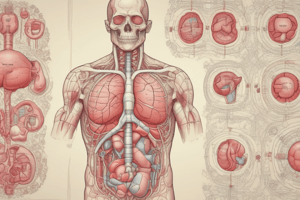Podcast
Questions and Answers
Which of the following correctly describes the role of the vasorecta in the kidney?
Which of the following correctly describes the role of the vasorecta in the kidney?
- The vasorecta helps to maintain a concentration gradient in the medulla, facilitating water reabsorption by the nephron. (correct)
- The vasorecta is responsible for transporting blood from the glomerulus to the Bowman's capsule, filtering waste products.
- The vasorecta acts as a primary filtration unit, removing waste products from the blood through the process of ultrafiltration.
- The vasorecta is the primary site of urine production within the kidney and is responsible for concentrating waste products.
What is the primary function of pepsinogen in the digestive process?
What is the primary function of pepsinogen in the digestive process?
- Pepsinogen acts as a hormone, stimulating the release of bile from the gallbladder.
- Pepsinogen is converted into pepsin, an enzyme that digests proteins into smaller peptides. (correct)
- Pepsinogen breaks down carbohydrates into simpler sugars, aiding in their absorption.
- Pepsinogen helps to regulate the pH of the stomach by neutralizing acid.
Which of the following accurately describes the difference between open and closed circulatory systems?
Which of the following accurately describes the difference between open and closed circulatory systems?
- Open circulatory systems rely on a separate lymphatic system for fluid circulation, while closed circulatory systems do not have a lymphatic system.
- Open circulatory systems have a heart that pumps blood into a system of sinuses, allowing direct contact with tissues, while closed circulatory systems use distinct blood vessels. (correct)
- Open circulatory systems have a heart that pumps blood directly to the tissues, while closed circulatory systems use a network of vessels.
- Open circulatory systems have a heart that pumps blood through a network of vessels, while closed circulatory systems rely on diffusion for oxygen exchange.
What is the primary function of the tracheal system in insects?
What is the primary function of the tracheal system in insects?
Which of the following statements correctly describes the role of epinephrine in the thermoregulation process?
Which of the following statements correctly describes the role of epinephrine in the thermoregulation process?
Flashcards
Endocrine System
Endocrine System
A collection of glands that produce hormones regulating various bodily functions.
Nephron
Nephron
The functional unit of the kidney responsible for filtering blood and forming urine.
Cardiac Cycle
Cardiac Cycle
The sequence of events in a heartbeat, including contraction (systole) and relaxation (diastole).
Hemoglobin
Hemoglobin
Signup and view all the flashcards
Peristalsis
Peristalsis
Signup and view all the flashcards
Study Notes
Internal Environment and Tissues
- Types of tissues: Epithelial, connective, muscle, and nervous tissues are key.
- Epithelial cells: Variety of shapes and functions.
- Connective tissue fibers: Different types of fibers (e.g., collagen) provide support and structure.
- Bone structure: Bone is a specialized connective tissue.
- Muscle tissue: Different types (skeletal, smooth, cardiac) with varying functions.
- Glial cells: Support cells in the nervous system.
- Endocrine system: A network of glands secreting hormones.
- Endocrine vs Nervous: Compare and contrast their modes of communication and response.
- Endocrine organs: Know specific endocrine glands and organs (e.g., pituitary, thyroid, adrenal).
- Feedback regulation: How hormone levels are maintained within a stable range.
- Endocrine cascade: A series of hormonal responses.
- Posterior pituitary hormones: Examples and functions (e.g., oxytocin, ADH).
- Epinephrine: Adrenaline's role in stress response.
- Thermoregulation: Maintaining body temperature.
- Vasodilation and vasoconstriction: Blood vessel changes regulating heat loss.
- Countercurrent heat exchange: Mechanism in mammals and birds for conserving heat.
- Urinary excretion: Removal of metabolic wastes from the body.
- Nephrons: Filtering units in the kidneys; their functional segments.
- Planaria: Simple excretory systems.
- Malpighian tubules: Structure and function of excretion in insects.
- Vasa recta: Capillaries surrounding nephrons.
- Antidiuretic Hormone (ADH): Importance in water balance.
Digestive System
- Essential nutrients: Amino acids and fatty acids are essential.
- Intracellular digestion: Food breakdown within cells.
- Alimentary canals: Variation across species.
- Peristalsis: Movement of food through the digestive tract.
- Digestive enzymes: Examples like pepsin and hydrochloric acid (HCl) and their functions.
- Pancreas and liver: Their roles in digestion and nutrient processing.
- Pepsinogen/pepsin: Conversion and function of enzymes.
- Microvilli: Surface area increases for absorption.
- Chylomicrons: Transport of digested fats.
- Ruminants: Specialized digestive adaptations in grazing animals.
- Hormonal control of digestion: Regulation of digestive processes.
Circulatory and Respiratory Systems
- Single and double circulation: Comparative anatomy and physiology.
- Cardiovascular system: The heart and blood vessels.
- Cardiac cycle: Systole and diastole phases.
- Stroke volume: 70 ml of blood pumped per contraction.
- ECG (Electrocardiogram): PQRST waves for assessing heart function.
- Blood vessel structure: Arteries, veins, and capillaries.
- Lymphatic system: Part of the circulatory system; role in immunity and fluid balance.
- Blood Cells: Monocytes (largest), platelets, erythrocytes (red blood cells).
- Sickle cell anemia: Genetic disorder affecting red blood cells.
- LDL and HDL: Types of cholesterol.
- Hypertension: High blood pressure.
- Parapodia and gills: Respiratory adaptations in some invertebrates.
- Ventilation: Movement of air or water for gas exchange.
- Countercurrent distribution: Efficient gas exchange in aquatic animals.
- Tracheal system: Respiratory system in insects—tubes directly delivering air to tissues..
- Respiratory systems: Lungs, gills.
- Bird respiration: Unique adaptations for efficient gas exchange.
- Hemoglobin transport: Oxygen carrying function of hemoglobin.
Studying That Suits You
Use AI to generate personalized quizzes and flashcards to suit your learning preferences.



